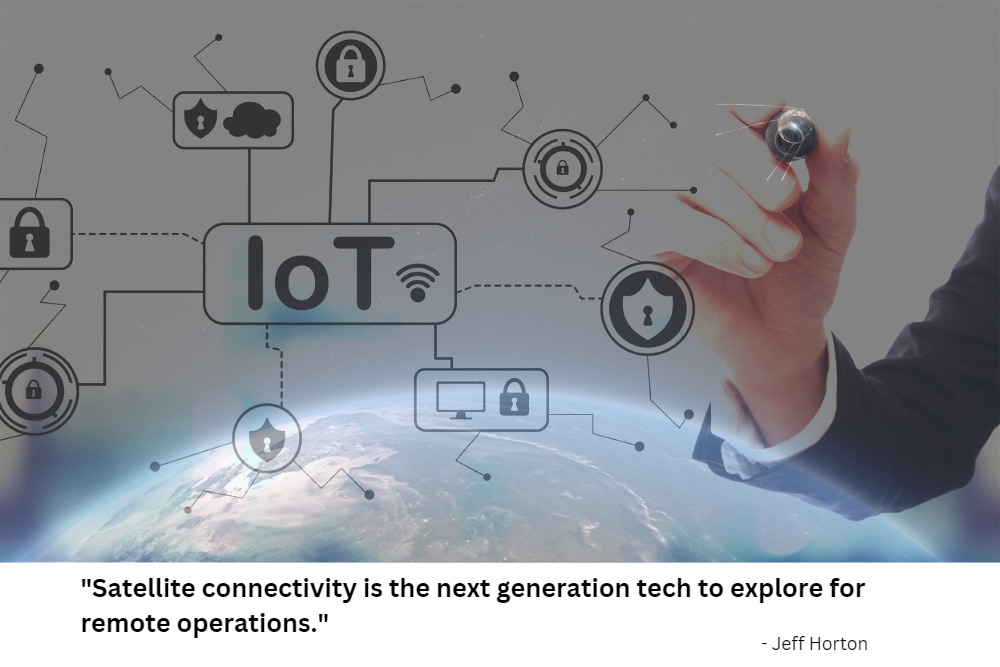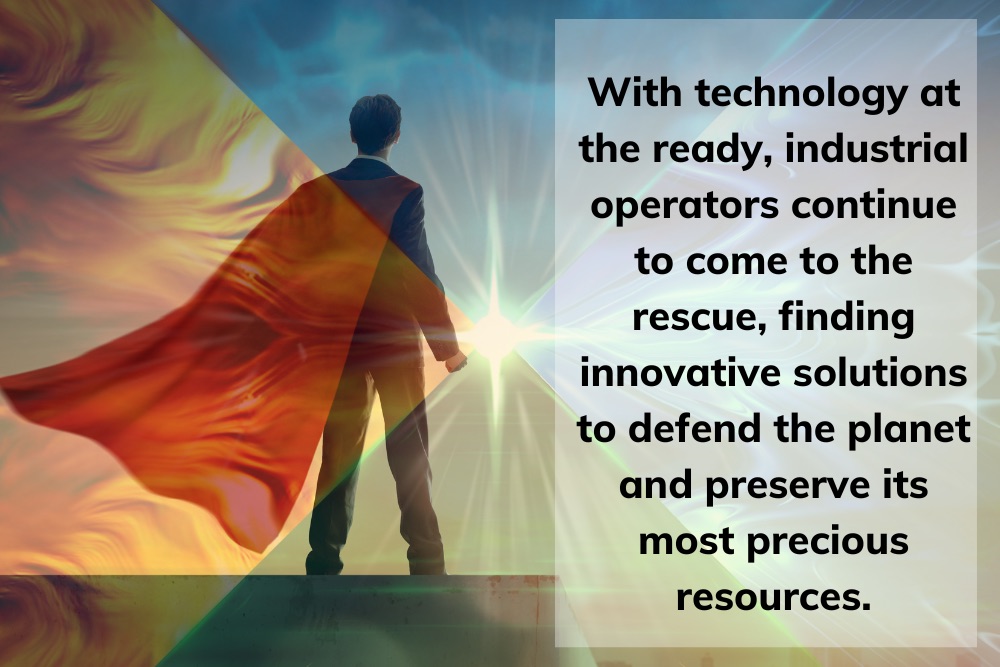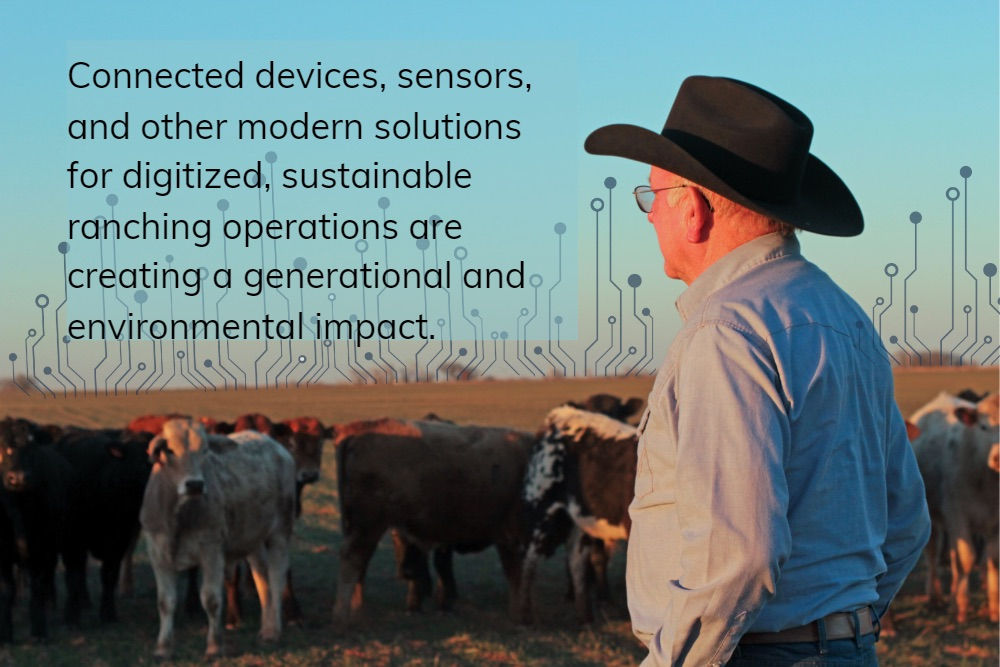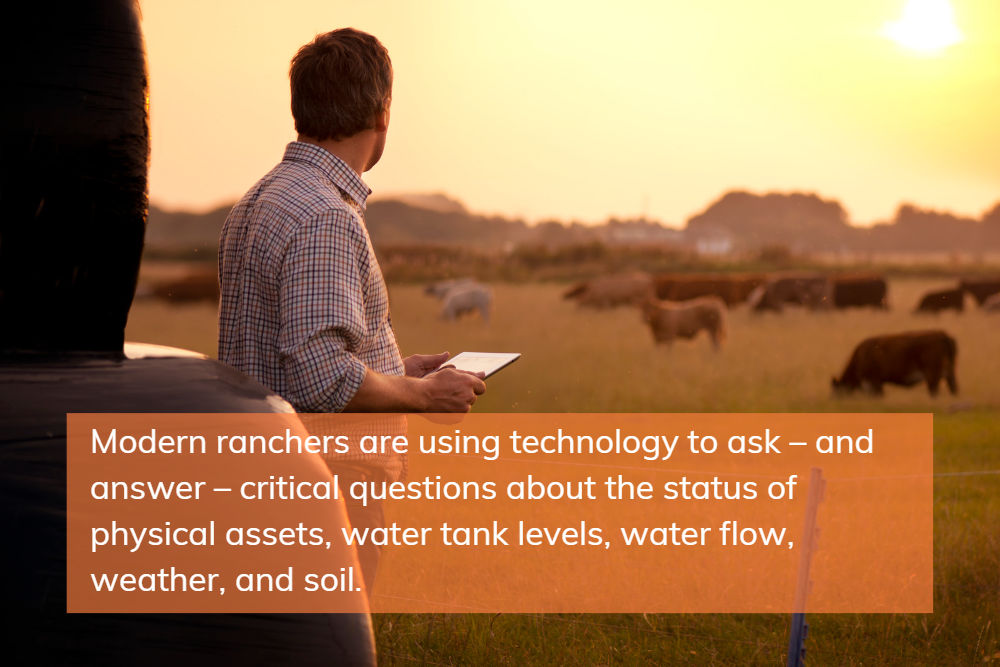Satellite Connectivity Becomes Next-Generation Tech for Remote Operations

The future of IIoT connectivity is up in the air — literally. Space is the new frontier for IIoT connectivity, as satellite connectivity is fast becoming the networking solution of choice for many industrial use cases. IIoT, or the industrial internet of things, refers to an ever-expanding ecosystem of sensors, networking equipment, and analytics, which work together to collect, transmit, and analyze data from “things” used in industrial operations. Data transmissions from industrial assets help guide business decisions or automatically trigger actions. For example, in agriculture, IIoT-enabled irrigation systems monitor soil moisture levels, weather forecasts, and other data points to help growers determine the best time to water, or the IIoT solution can automatically activate sprinklers without human intervention if programmed to do so. When talking about satellite, this two-way communication reveals the next-generation tech for remote operations. First, though, let’s take a quick glance back. What Satellite Connectivity Means for People in Remote Areas FreeWave started by helping customers transmit mission-critical data using radio technology in 1993. We’ve seen the evolution of communications since then, with not only our rugged wireless radios continuing to serve the future of the oil and gas industry, but also the advancement of satellite for people leading remote operations. Traditionally, IIoT has mostly relied on cellular connectivity and other terrestrial solutions for data transmission, but as IIoT continues its push into underserved locations — from remote grazing pastures in Colorado to offshore oil platforms in the Pacific Ocean — cellular solutions pose some serious limitations. Connecting people, not things, is the foundational purpose of cellular infrastructure development, so in sparsely populated or remote areas, cellular service may be limited or even surprisingly unavailable. While other non-cellular connectivity solutions exist, for certain circumstances, satellite is becoming a more viable solution, offering distinct advantages. Competition is driving rapid innovation in the IIoT satellite space even as it drives down costs. As a result, companies that previously encountered lack-of-coverage or cost barriers with the various terrestrial networking options now have an affordable IIoT connectivity solution in the form of satellite — with cost savings between four and 20 times what they once might have paid. Satellite connections are, by definition, wireless and don’t require remote operators to install fixed lines — DSL lines or coaxial cable — for data transmission. This added flexibility gives companies the freedom to scale their IIoT applications quickly and easily as their needs and business goals evolve. For example, a major agriculture company with an expanding customer base in remote parts of Brazil, Argentina, and Chile announced it will use satellite connectivity to operate autonomously driven tractors in those countries. In these remote areas with no cellular or Wi-Fi coverage, real-time communication through satellite connectivity allows farmers to stop and start the tractors and other unmanned equipment, monitor the equipment’s performance, and determine what to do when a tractor encounters an obstacle — all through an app-based control panel from afar. Meet LEO and GEO Not all satellites are created equal, however. There are three common satellite types: Low Earth Orbit (LEO) satellites, Medium Earth Orbit (MEO) satellites, and Geostationary Equatorial Orbit (GEO) satellites. LEO and GEO represent the two altitudinal extremes and are most commonly used for IIoT connectivity. LEO satellites are smaller and orbit closer to the earth, so launching them is less expensive. LEO satellites circle the earth several times a day, so multiples are needed to fly in succession over the target geographic area in order to provide consistent coverage and avoid dataflow disruptions. The ground equipment needed to monitor and maintain LEO satellite constellations is also extensive. GEO satellites — a type of geosynchronous orbit (GSO) satellite — also orbit the earth, but they do so along the equator in the same direction and at the same rate the earth is spinning. Hence, from our vantage point, a GEO satellite looks like it’s standing still since it is always above the same location. Its daily orbit notwithstanding, a GEO satellite, for all intents and purposes, stays “parked” above the area that needs coverage. Since GEO satellites are continuously visible, ground station tracking is not required, and their greater height offers substantially more geographic coverage; in fact, only three GEO satellites can provide whole-earth coverage. LEO satellites and GEO satellites both have their place in IIoT connectivity. With less distance for signals to travel, LEO satellite solutions historically have offered lower latency rates and higher bandwidth capabilities, although newer GEO satellite solutions offer these capabilities now, as well, with a signal-bounce delay of about one-quarter of a second. The end user’s needs, business goals, and budget will determine which IIoT satellite solution is best. We’re seeing an increasing need for two key requirements for satellite connectivity — real-time or near real-time data transmission and two-way communications. Can Satellite Connectivity for Remote Operations Minimize the Impact of Catastrophes? Environmental catastrophes happen more frequently than we are even aware. Being able to positively impact a critical issue before it happens is certainly the goal of many. IIoT and its network-connected sensors and dataflow provides the catalyst for alarming and alerting to help alleviate the impacts of disastrous situations whether they be natural phenomenon, human error, or otherwise created. FreeWave has expanded our footprint in the environmental space, helping customers deploy early-detection IIoT sensors that alert the appropriate personnel in the event of a disaster. Let’s take the case of a timber company using sensors to detect lightning strikes or approaching wildfires. Strategically placed sensors are programmed to detect various gas profiles indicative of those events. A delayed alert could spell disaster, so real-time notifications are of paramount importance. The same is true for oil and gas companies that receive alerts before a catastrophic equipment malfunction—real-time alerts to what’s happening in the field could save millions of dollars and prevent environmental devastation and other ramifications. One-way and Two-way Satellite Communications In many use cases, two-way communication is needed to optimize industrial operations. Some IIoT connectivity solutions only transmit data one way, from the
2023 and Beyond: A Visionary Q&A with FreeWave

With fresh insight and excitement for the year ahead, the FreeWave leadership team discusses their vision for the future, predictions about the evolution of data, and collective approach to protecting life’s essentials. Though you might not find their names in the next Marvel film or DC comic book, industrial leaders – whether in agriculture, energy, utilities, or another resource industry – are the heroes of the modern world, real-life Guardians of the Galaxy, if you will. These heroes fight today’s challenges every day, while life’s essentials like food, air, energy, and water are threatened daily. With technology at the ready, industrial operators continue to come to the rescue, finding innovative solutions to defend the planet and preserve its most precious resources. At FreeWave, our goal is to continually build upon technology advancements to help you build a better world within your industry. With 2023 right around the corner, we asked four of FreeWave’s senior leaders, including Kirk Byles (CEO), Michael Tate (COO), Parthesh Shastri (CTO), and Jeff Horton (CRO) to share their thoughts on how FreeWave Technologies is helping the heroes of today protect life’s essentials to create a better tomorrow. ___________________________________________________________________ Q: What is one of your favorite FreeWave memories from this past year? Kirk Byles: It’s hard to even remember before this quarter, but the Reinke Dealer Conference was definitely a top highlight for me this year. Not only did it show the work our collective teams have been doing to build relationships and finalize a new product offering, but it was also really cool to see the impact our work is having in real-time, as we partner with Reinke – one of the largest pivot irrigation manufacturers in the world – to help growers and producers save water and raise crops. This was really big. Parthesh Shastri: This year, we really came together across disciplines within FreeWave, too, increasing our focus on target outcomes to deliver products that our customers use and deploy in the field, and we had a lot of fun while doing it! As we look at 2023, we are excited to scale this model and implement it across new industries. Q: How is FreeWave helping industrial operators protect life’s essentials? Jeff Horton: The top thing that comes to my mind is bringing automation to irrigation. We work closely with our partners, like Reinke, to provide real-time analytics, which saves a lot of water and nutrients, and both of these things are invaluable for farmers. Technology also helps to reduce fuel consumption on ranches by eliminating the need to manually check cattle watering tanks. Some producers often spend 12 to 15 hours a week driving around just to look at their water tanks. Think about the wear and tear on those pickup trucks or even the rising cost of fuel. Being able to reduce greenhouse gas and save these guys money while also producing a high return on investment is a really big deal. We can do that easily with the Tank Level Monitor. Mike Tate: And it’s not just the ROI. These producers are suffering. Ranching is not the lucrative business that it once was, and these ranchers are getting beaten at every turn. A lactating cow needs one gallon of water for every hundred pounds, every six hours! Water is a huge concern for both producers and growers, and being able to give them back more time while reducing their expenses is a great value add because every dollar counts for them. Q: Is the word “efficiency” changing for industrial operators? Jeff: When you look at conditions today, both here in the United States and globally, you see so many labor shortages, droughts, inflation, and climate changes, and it’s forcing efficiency, not for efficiency’s sake, but for sustainability and survivability. Businesses have to fundamentally change the way they produce a product, and they have to find the least expensive, most efficient path to go to market. Efficiency isn’t an option anymore; it’s a necessity. Kirk: For years, everybody has wanted to do more with less, and usually, there’s some sort of limitation in the way until someone invents a solution that takes things to the next level. That’s what we’re all about at FreeWave. We’re not doing anything necessarily earth-shattering; but we are innovating. We’re providing a mechanism for our customers to become more and more operationally efficient – to increase their bottom line – and make things better, and not just for their business, but for their employees and life, in general. Case in point: oil and gas companies, considered by some to be big polluters. However, these companies have many sustainability and environmental initiatives and tenants they strive to uphold. They are a critical component of our everyday lives. They’re evolving and innovating, too. FreeWave, helps them get the most out of the equipment they have on-site so that they’re more effectively getting the oil and gas out of the ground with minimal impact. Overall, a more efficient company means less impact on the environment, and these kinds of solutions help create a better planet. Q: In your wildest imagination, where can technology take the industrial leader in the next ten years? Parthesh: There are so many great examples. In China, there’s currently a 12-story tall facility being built to raise hogs in a conditioned environment. It’s like an office space for swine. In this environment, technology is being used in such a way that human intervention is really minimized, and because most things are entirely data-driven, they are able to be a lot more efficient. Now, there are pros and cons to what’s taking place there, and we won’t know the final outcomes for a while, but the march of technology is going to continue to go on, and I believe we will continue to see a lot more practices like this in the future. Jeff: Another example is indoor growing facilities in Saudi Arabia and Qatar. Massive facilities that are purpose-built for farming simply because there is
Ranch Life: Water Visibility is Critical Part 2

Measurement is part of a farmer’s DNA. It improves plant yields, herd health, resource conservation and impacts the bottom line – from ensuring livestock reach their peak for maximum prices at auction to guarding against overgrazed pastures. Observation and measurement, especially for the stewards of our land, determines performance in many categories of a ranch’s operations. In Part 1 of this series, we explored how the metrics of today and those of the original homesteaders varies in one significant way: technology. A quick recap: The Internet of Things (of the ranch) or IoT is like having an extra set of “eyes and ears” spread across the ranch. In short, connected devices are bringing near real-time visibility into what is happening in disparate parts of the ranch. How do all those devices spread across thousands of acres bring value? Here are five scenarios modern ranchers are using to transform their operations. Scenario One: Instead of rolling out trucks to check water usage in stock tanks, ranchers are saving time using alerts or checking tank levels on their devices Tank level and creek/river monitoring solutions (FreeWave Water Level Monitor) help ranchers manage water usage better. In the past, and to some effect still today, farmers and ranchers don’t know how much water they use. Inexpensive and simple-to-deploy sensors in tanks, aquifers, springs, and pumps allow ranchers to know exactly what is happening with water usage and make intelligent decisions about watering pastureland and hayfields, filling tanks, and moving water. (click here for a special price offer for a limited time) Ranchers are in the “driver’s seat” (without ever leaving their chair) by setting parameters – thresholds like water levels or flow. Technology can seem complicated to many of us sometimes, but the IoT devices we are talking about are not. Drop-in remote sensors simply plug in so ranchers can see what’s happening, in near real-time, rather than driving across thousands of acres in a gator to check hundreds of troughs and water supplies. Ranchers can easily monitor water levels in tanks 24/7 without routine in-person maintenance checks. (Bonus: there are no set-up fees with our solution.) Scenario Two: Paperwork is easier and faster using real data. Less manual inspections mean safer working conditions and less vehicle costs A digital ranch goes beyond automatic water distribution; it also includes insight and access to data metrics to help monitor and stay within local water use regulations. Ranching operations require lots of paperwork, especially those using public lands for grazing. For irrigation systems that take water from a natural resource such as an on-farm stream or river, data helps ranchers measure water availability and flow. By rolling out fewer trucks to check on stock tanks, there’s less wear and tear on trucks and less man-hours dedicated to manual inspections. Scenario Three: Soil moisture level monitoring improves grazing health Not only can digital solutions enhance the quality of water production on a ranch, but they can also play a role in helping to visualize and maintain the quality of the soil for high quality grass for grazing. Sensors determine soil moisture levels and overall health from the air. Better soil means a better ranch, and a better ranch means healthier land, livestock, and profitability. With near real-time data in hand, ranchers can make more informed decisions – just like they always have through observation and measurement – about soil behavior. For example, knowing actual soil moisture levels influence when to rotate cattle on different fields so ranchers can fertilize the land, continually giving fresh grass for the cattle to munch on. Scenario Four: Preparing for adverse weather A string of hot days, the possibility of wildfires, and water scarcity along the Great Plains changes the game for ranchers. No one can control the weather, but technology can help ranchers prepare. Virtual visibility into the surrounding climate of a ranch utilizes timely data to prepare and respond to natural weather updates and climate changes like wildfires, wind erosion, or soil erosion that might threaten ranchland management. Good decision-making and preparedness reduce energy costs and environmental impact. Scenario Five: Carbon dioxide detection is no longer a guessing game Last, but certainly not least, carbon dioxide detection is a game-changing tool for today’s rancher. With the right sensors in place, you can both manage your carbon dioxide emissions and monitor your CO2 levels to ensure better, more drought-resistant soil, which will ultimately aid in the sustainability of water conservation practices. With technology being the “ears and eyes” of the rancher, less money is spent on diesel and, as previously mentioned, wear and tear on trucks rolling out to different sites. The Road to Lean and Mean For those tending vast, open, and oftentimes remote expanses of land, FreeWave’s simple-to-use solutions are turnkey. These modern solutions for digitalized, sustainable ranching operations are creating a generational and environmental impact. They are up and running within 10 minutes or so. Using just about any device – cell phone, tablet, laptop, or desktop computer – ranchers see a dashboard, or what we like to call a single pane of glass. It sounds almost crazy, but FreeWave technology can work in virtually any environment, no matter how remote. Like many customers we serve, we put in our time to hone our craft: we started 30 years ago as a U.S. manufacturer of mission-critical wireless data radios operating in the harshest and most dangerous places for the military. FreeWave has created low-cost ranch coverage solutions to monitor stock tanks, water troughs, rivers, dams and other water supplies in areas with limited or no cell coverage using a variety of solutions, including satellite, cellular, Wi-Fi, Bluetooth, and more. Contact us to learn how you can get valuable time and money back from your ranch operations.
Ranch Life: Water Visibility is Critical Part 1

There is no average day in the life of a rancher. Many kickstart their morning at 4 a.m., when most people are still fast asleep. After breakfast, the real work and the long day begins. It might include mending fences, checking grass levels across thousands of acres, rotating cattle or even being called unexpectedly to tend to a neighbor’s sick animal. All this is done by riding the land or rolling out trucks in hard-to-reach places with little or no cell coverage – and so much connects back to water. From land and hay operations to logging and livestock operations, water conservation touches almost every aspect of ranch performance and profitability. Take JJ Goicoechea, for example, who travels at least 40 miles a day (one way) to check on the viability of the water on his land for the surrounding cattle and wildlife. Or Bob Skinner, who used his own funds to purchase an airplane as a means to check on his pipelines every 48 hours. These examples, courtesy of the Public Lands Council, show observation and measurement for better on-ranch performance is nothing new for ranchers. What has evolved is how the modern rancher observes and measures today with near real-time visibility, particularly when it comes to water management. Water Becomes a Commodity It’s no secret that water is a rancher’s most valuable asset. Safe, clean, abundant water sources are necessary for the health of the herd. Water impacts the profitability of ranch operations, many of which were handed down from previous generations. There’s a new challenge, though, that the men and women who homesteaded the land did not have to contend with: extreme weather and unreliability of water sources. Case in point: 2012, when two-thirds of the lower 48 states were in a drought. Or earlier in 2022, when according to the U.S. Drought Monitor, more than 32% of western states, including Texas, Utah, Oregon, and New Mexico, were in a severe drought – the worst megadrought reported in 1,200 years, according to Scientific American. With the unpredictability of nature and the need to conserve reliable, clean sources of water, a better, more efficient way to store and sustainably save water is surely needed. What if You Could See the Entire Ranch on Your Device? Just like their forefathers, a rancher’s keen eye for observation and measurement serves them well. There’s a gut check to making decisions, and experience guides the way. That will never change. The modern cowboy, however, is evolving in one significant way: they can now see their entire ranch operation in real-time on a connected device: cell phone, tablet, laptop or desktop computer. Here is how near real-time visibility – being able to see the different parts of a ranch without physically being there – works. Sensor technology “carries the water” for ranchers and farmers, helping them visualize what’s happening across thousands of acres without having to physically roll out trucks. These devices, or “things,” then relay data back to ranchers so they can make informed decisions based on near real-time visibility. It’s like having extra “eyes and ears” spread across the ranch. In short, these connected devices are the Internet of Things (of the ranch) or IoT, for short. FreeWave provides a drop-in solution – our Tank Level Monitor – that’s easy to install, set-up, and manage. For any of us, you don’t know what you don’t know. For ranchers, this knowledge gap comes with a price as rising fertilizer, equipment, and input costs squeeze margins. Every unexpected cost is closely watched. A dehydrated calf in peril costs more than a thousand dollars to replace. A blown tire on a truck shows up on the P&L. Man-hours spent checking water levels and the status of equipment add up. When it comes to water consumption, IoT is making a difference. According to a research report conducted by Transforma Insights and 6GWorld, by 2030, connected devices and the information they impart will help conserve close to 230 billion cubic meters of water. What does that even look like? Here, we turn to beer to help us out. Considering 40 million cubic meters of water is equal to about 300 billion pints, IoT is predicted to save the same amount of beer consumed at Oktoberfest in Munich for two straight decades. That’s a lot of water saved. While 35% of those savings will come from smart water grid operations, the remaining 65% will be driven by “IoT-enabled agricultural operations like crop management and remote pest control,” according to the report. What Observing and Measuring Means Today Connected devices save valuable time, money, and resources. They give ranchers “eyes and ears” into their entire operation and support what these stewards of our land have always done well: observation and measurement. Modern ranchers are using technology to ask – and answer – critical questions about the status of physical assets, water tank levels, water flow, weather, and soil, like: Do the stock tanks have enough water to keep the livestock healthy? Is there excess water in the soil that will lead to ponding? Are we irrigating the hay fields with too much or too little water? Are equipment like livestock trailers and tractors running smoothly? What’s the condition of remote pumps – are they working, is there a leak, is the herd getting what they need when they need it? A long-held rule for ranchers is that they don’t quit when they’re tired, they quit when they’re done. We aim to support ranchers in getting more of the right things done – with less water, waste, and worry. Talk to FreeWave today and see how our solutions can help you save time, energy, and money with a drop-in solution that just makes sense.




